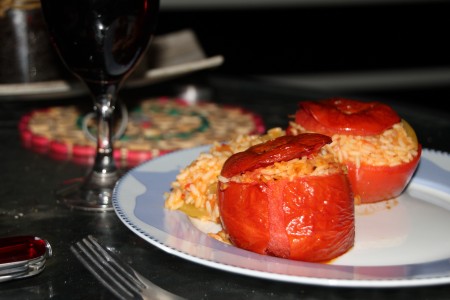 Gluten Free Diet:
Gluten Free Diet:
Many thanks to Lok for this awesome pic of gluten free food: Stuffed Red Capsicums With Rice.
Here are a few of my most favourite easy gluten free recipes for you to try.
You also might like to look at merrilyn’s post entitled ‘Complete List of Gluten Free Foods’ and the cookie site Gluten Free Cookies.info
This collection of gluten free recipes has to begin with the ‘humble-pie’ cornmeal polenta porridge. Cornmeal, and brown rice, are the two grains which you will use a lot in your gluten free cooking. These are very nutritious, and, with the added help of a bit of soy, or chick pea flour, or arrowroot, you can learn to cook delicious wheat-free dishes: your visitors will never know the difference.
Polenta Porridge is a great way to start the day. You can add a grated apple to the serving of polenta, some olive oil, a dash of butter, or cream, or your favorite sort of milk, and you have a good, nourishing, high fiber, gluten free breakfast.
To make Polenta Porridge
- Take a cup of yellow cornmeal groats. OR you can use fine, yellow cornmeal instead.
- Add a 1/4 tsp of sea salt.
- If you wish, add 1/2 cup of dates, or sultanas or raisins, to sweeten.
- Add two cups and a half of water. Groats are best if you can soak them for an hour, as this quickens the cooking time and results in a softer porridge. If you are using fine yellow cornmeal, then mix the water in slowly as you stir, to get all the lumps out before you begin cooking.
- Stir the polenta as you cook it over the stove. Once it is bubbling, turn the heat down to low and cook for a further five minutes on gentle heat. Remember to stir frequently.
- If you can digest butter, then stir a tablespoon or two of butter nto the cooked polenta, just before you serve it. Butter renders the polenta ‘delicious’. If you do not wish to use butter, then add a tablespoon of olive oil or grapeseed oil to the plate of polenta. Butter or oils add nourishment to the polenta, and help digestion and assimilation of vitamins and minerals.
- You can add sunflower seeds, sesame seeds and chopped almonds to give the polenta great flavor, texture, and added nourishment.
Flours for Gluten Free Pancakes
- You can use any combination of these flours to make gluten free pancakes:
- Arrowroot
- Chick pea flour, or ‘Besan’ flour
- Fine yellow cornmeal
- Potato flour
- Rice flour
- Soy flour
- Tapioca flour
Here is a combination for Gluten Free Pancakes which works well. These gluten free pancakes are great rolled up as a sweet, with maple syrup and whipped cream, or simply lemon juice and heavy brown sugar. Or they can be used with your favorite savory filling.
- Get your measuring cup. Put in two tablespoons of chickpea flour, and two tablespoons of fine yellow cornmeal.
- Top up the cup with arrowroot flour, or soy flour.
- Break two large eggs in a bowl. Beat slightly.
- Add half a cup of your favorite milk to the eggs, and beat again.
- Add two tablespoons of olive oil, or grapeseed oil to the egg and milk mixture.
- Add the cup of flour and a pinch of salt. Beat until smooth.
- Add two more cups of milk. Beat.
- Finally, add the juice of half a lemon.
Let the mixture stand for an hour before cooking.
Heat your heavy fry pan up. Add a teaspoon of butter, and spread it over the pan. Make sure the pan is hot, and then add a good half cup of batter to the pan. Tilt the pan so that the batter covers the base of the pan. Cook until small bubbles begin to appear in the batter, and it has firmed nicely, then flip and cook the other side.
Fill with your favorite filling.
Delicious Gluten Free Lemon Pudding
This pudding really is delicious, with a firm custard underneath it, and a light foamy sponge on top. It can be made with dairy milk, or with soy milk if you prefer. I have used coconut milk to make this pudding, and this has also been delicious, and a great hit with the family.
First, preheat your oven to 180C.
- Two tablespoons of butter
- 200 gm of sugar
- Juice of two lemons
- Two teaspoons of finely grated lemon rind. Make sure you do not get any of the white flesh included, as this gives a bitter taste.
- Four eggs.
- One tablespoon of chickpea flour
- One tablespoon of rice flour
- One tablespoon of arrowroot or tapioca flour.
- 250 mls of milk
- Optional – 2 tablespoons of coconut can be added for variety.
Grease your oven proof dish with a smear of butter, or olive oil.
Cream together the butter, sugar and lemon rind. Add the egg YOLKS. Mix in well, then add the flours, milk and lemon juice. Beat again.
In another clean bowl, beat up the egg whites with a pinch of salt. When peaks have formed, fold this beaten egg white gently into the first mixture.
Pour into your greased baking dish, and bake for about 25 minutes, or until the pudding is set and browned slightly.
Serve with cream, or stewed fruit.

